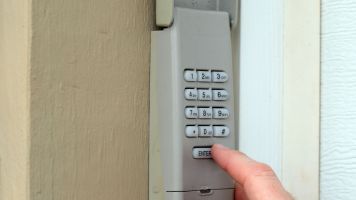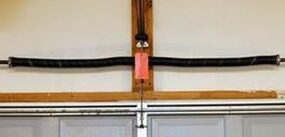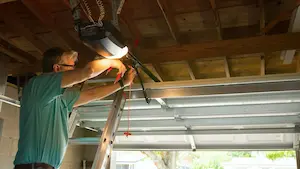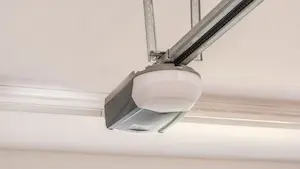Common Garage Door Problems And How To Fix Them
This post contains affiliate links.

When your garage door is not working, it can be frustrating and inconvenient. From unresponsive remotes to noisy operations, the problems vary widely.
This article explores the most common garage door problems, explaining their possible causes and providing step-by-step solutions to help you fix them efficiently.
Whether you’re dealing with a faulty opener or misaligned tracks, our guide ensures you can handle these issues promptly, restoring functionality and safety to your garage door.
Common Garage Door Problems And How To Fix Them
| Component | Common Problems | How to Fix |
| Logic Board | – Door won’t open or close- Unpredictable behavior | – Inspect for damage and moisture- Replace if necessary |
| Opener Sensors | – Door reopens immediately or doesn’t close- Door stops or reverses unexpectedly | – Clean and realign sensors |
| Remote Control | – Remote not working- Remote loses connection with opener | – Replace batteries- Move closer to opener and re-sync |
| Wires | – Door stops or doesn’t respond | – Inspect and replace damaged wires |
| Opener Gears | – Grinding noise- Door stops moving after starting | – Replace worn or broken gears |
| Motor | – Motor runs but door doesn’t move- Motor struggles without moving door | – Check power source- Replace necessary parts like capacitors or belts |
| Emergency Release | – Door operates roughly or gets stuck | – Re-engage and lubricate the release mechanism |
| Springs | – Door hard to operate- Door moves unevenly or slams | – Replace springs (by a technician) |
| Cables | – Door uneven or stuck- Jerky or tilted door movements | – Replace damaged cables |
| Rollers | – Door opens or closes with difficulty- Noisy or stuck door | – Replace damaged rollers and lubricate |
| Tracks | – Door sticks or jerks- Noise during operation | – Clean and adjust tracks or replace if damaged |
| Limit Settings | – Door doesn’t fully close or reverses unexpectedly- Door impacts ground too hard | – Adjust the limit settings to ensure proper door movement |
Logic Board
When your garage door won’t open or close, it’s often due to a malfunctioning logic board in your garage door opener. This small but crucial component acts as the brain of the opener, sending signals to control the door’s movements.
If the logic board is faulty, your garage door may behave unpredictably, failing to respond to your remote control or even opening and closing randomly.
To troubleshoot this common garage door issue, you should first check for obvious signs of damage, like burn marks or unusual smells from the opener—these can indicate a burnt-out logic board.
Moisture is another enemy of garage door logic boards. This could be the culprit if you’ve had recent flooding or leaks in your garage.

Repairing a logic board is not typically a DIY garage task due to the complexity and the risk of further damaging your garage door opener. The most effective approach is to call a garage door technician.
They can diagnose the problem accurately and often replace the logic board quickly, ensuring your garage door operates smoothly again.
Garage Door Opener Sensors
A garage door opener sensor ensures your door opens and closes properly. Located near the bottom of the door track on either side of the garage, these sensors detect if anything is in the way of the closing door.
Suppose your garage door doesn’t close or opens back up immediately after trying to close. In that case, you might be facing a sensor issue.
Bad sensors can make your garage door stop midway or reverse suddenly, preventing it from closing. This safety mechanism is crucial but can be frustrating when misaligned or dirty sensors trick the system into thinking there’s an obstruction when there isn’t. Common issues that can also affect the sensor’s operation include:
- cobwebs,
- dust, or even
- direct sunlight.
To troubleshoot, you should first clean the lenses with a soft cloth. Minor obstructions like leaves or debris can also block the sensor’s beam—clearing them away can quickly solve the problem.
If the garage door still doesn’t operate correctly, check for alignment. The sensors should face each other directly; even a slight misalignment can cause issues.
If you find they are out of alignment, gently adjust them until the receiving sensor’s indicator light shows a steady illumination.
Read all about garage door sensors here.
Garage Door Remote Control
Your garage door remote control is a key tool that lets you open and close your garage door conveniently from a distance. But when it stops working, it can be a problem leaving you unable to easily access your garage.
Garage door remotes may have dead batteries, which is the simplest problem to fix. Simply replace the batteries and see if the remote regains functionality.
Another less obvious issue might be interference from nearby wireless devices. Try bringing the remote closer to the garage door opener to check if distance is the problem.
If your garage door remote still doesn’t work, it could be due to the remote or the garage door opener’s receiver losing synchronization. Re-syncing them according to the manufacturer’s instructions can often resolve this.
Also, check if the remote’s signal is being blocked by new installations or objects within your garage.
Sometimes, the problem is with the remote being damaged or worn out. If the buttons are sticky or you’ve dropped the remote too many times, it may be time to get a new garage door remote.
Read more about garage door remotes here.
Wires
Garage door wires are essential for the smooth operation of your garage door, particularly if you have an automatic system.
These wires, part of the garage door’s electrical system, are crucial for sending signals from the remote control to the garage door opener, facilitating the open and close commands.

If these wires malfunction, your garage door may not respond correctly to the remote. You might find the door stops midway or it doesn’t move. Sometimes, the door may seem to have a mind of its own, opening and closing unpredictably.
These symptoms often point to frayed or loose wires, which disrupt the signal between the remote and the opener.
First, ensure your safety by disconnecting power to the garage door opener to troubleshoot this issue. Look at the wires for any signs of wear or damage.
If you spot frayed or corroded wires, it’s best not to handle these repairs unless you have electrical experience.
Regular inspections can help catch such problems early. During routine maintenance, check the condition of all visible wires and ensure they are securely attached and free of damage.
This can prevent many common garage door problems and extend the life of your door’s electrical components.
Garage Door Opener Gears
Garage door opener gears are crucial for the smooth operation of your garage door, converting the motor’s rotary movement into the linear action needed to open and close the door.
These gears, often made of plastic or metal, can wear down or break, which directly impacts the performance of the garage door opener.
If you hear a grinding noise or the garage door starts to move but then stops, the gears might be the issue. A common problem is stripped gears; signs include the motor running, but the door doesn’t move.
This typically occurs when the garage door is obstructed, or the springs are not properly counterbalancing the door, putting extra strain on the gears.
To repair malfunctioning opener gears, you first need to disconnect the power to the opener for safety. Remove the garage door opener cover to inspect the gears. Replacing them is your best option if you find they are stripped or broken.
Gear replacement kits are available, and many DIY enthusiasts can handle this task with basic tools. However, if you’re not confident in making these repairs or the problem seems complex, it’s wise to call a garage door technician.
If you’re interested in changing the gears yourself. You can find them on Amazon.
Regular lubrication of the gears can prevent many issues. Use a garage door lubricant suitable for the gear your opener uses.
Garage Door Motor
The garage door motor is the heart of your door opener, driving the mechanism that opens and closes the door. When this motor malfunctions, it can leave you with a garage door that won’t open or close properly, if at all.

A common sign of a problem is when you hear the motor running, but the door doesn’t move. This could indicate a disconnection between the motor and the door mechanism, often due to a broken chain or belt.
Another issue might be the motor straining without action, suggesting it’s unable to lift the door, potentially due to unbalanced garage door springs or a need for lubrication.
To repair a malfunctioning garage door motor, check the easiest components first. Ensure the motor’s power source is intact, and the outlet is functioning. If the motor hums but doesn’t start, the capacitor might fail.
This part is crucial for starting the motor; replacing it is a task you can do yourself if you’re handy with tools. You might need to either replace these parts or adjust their tension for a broken chain or belt.
If these fixes don’t solve the problem, it could be time to replace the motor. Given the complexity of garage door systems, installing a new motor is best handled by a garage door technician.
Garage Door Emergency Release
Every garage door equipped with an automatic opener has an emergency release feature. This allows you to manually open or close the door when the power is out, or the opener fails.
However, if the emergency releases malfunctions, it can lead to problems, such as the door not operating smoothly or getting stuck.
One common issue is when the emergency release is not properly engaged after use. You might find the garage door won’t open with the remote control or the door opener’s motor.
This happens because the release mechanism remains disengaged, breaking the connection between the door and the opener.
To fix this, you must first pull the emergency release cord toward the door, which should re-engage the mechanism. If the door still isn’t operating correctly, the emergency release lock or its cable may be the issue.
Inspecting these components for damage and ensuring they move freely can help identify the problem.
Sometimes, lubricating the garage door track and the emergency release mechanism can improve function and prevent future issues. If these steps don’t resolve the problem, it’s best to call a garage door technician.
They can assess whether parts of the emergency release must be repaired or replaced, ensuring your garage door returns to full functionality. Regular checks and maintenance of the emergency release are essential for safety and smooth operation.
Garage Door Springs
Garage door springs are essential for balancing the weight of your garage door, helping it to open and close smoothly. There are two main types of springs used:
- Torsion springs, which are mounted above the door
- Extension springs are on either side of the garage door track.
When these springs malfunction, the door may not operate correctly, becoming difficult to open or close, or it might stop moving entirely.
Suppose your garage door opens and closes unevenly or seems unusually heavy when trying to lift it manually. In that case, it’s likely a sign of worn or broken springs. Another indicator is if the garage door won’t stay open or slams shut, posing serious safety risks.
Repairing garage door springs is not a DIY task due to their high tension. Instead, call a garage door technician. They have the training to safely replace the springs and ensure your door operates correctly.
Regular maintenance can help to extend your garage door springs’ life. This includes lubricating the springs with garage door lubricant and checking their tension.
Preventative care can help you avoid common garage door issues and costly repairs, keeping your garage door running smoothly for years.
Garage Door Cables
Garage door cables are vital components that allow your garage door to work smoothly.
These cables are typically made of steel and are attached to the bottom corners of the door, running through the springs. When functioning properly, they help balance the door and prevent it from swinging uncontrollably.
Malfunctioning garage door cables can lead to several problems. If a cable frays or snaps, the door may hang unevenly or become stuck, unable to open or close fully.

You might notice that the door moves jerkily or tilts to one side when you try to operate it. This uneven movement can strain other components, like the garage door opener motor and tracks, leading to further issues and potential failures.
Repairing broken garage door cables is not a DIY project due to the high tension involved in the system. The best course of action is to call a garage door technician.
These professionals can safely replace the damaged cables and check the entire system to ensure everything else is in good working order, preventing future problems.
Regular maintenance can help your garage door cables to work longer. This includes:
- checking for wear and tear,
- lubricating the rollers and tracks, and
- making sure the cables are properly adjusted.
These steps will help keep your garage door operating smoothly and safely.
Garage Door Rollers
Garage door rollers are small but crucial components that help your garage door glide smoothly along its track. When these rollers malfunction, you might notice your garage door opening and closing with difficulty, producing a lot of noise, or even getting stuck.
Typically, garage door rollers wear out because of poor lubrication or accumulation of dirt and debris in the tracks. Misaligned tracks can also cause rollers to wear unevenly, leading to more significant garage door problems.
If rollers become worn, they can hinder the door’s ability to move efficiently. They may prevent the door from closing or opening fully.
Repairing or replacing malfunctioning garage door rollers can improve the operation of your garage door. First, inspect the rollers for wear and tear.
If you see cracked, broken, or stuck wheels, it’s time for a replacement. You can purchase new rollers from any home improvement store or through a garage door service company.
If you’re interested in changing the rollers yourself. You can find them on Amazon.
To replace the rollers, you should first:
- secure the door in an open position to relieve tension,
- remove the brackets holding the old rollers,
- slide the new rollers into place, and then,
- reattach the brackets.
Garage Door Tracks
Garage door tracks are critical components that guide the door as it opens and closes.
Suppose these tracks are misaligned, bent, or obstructed. In that case, you might find that your garage door doesn’t move smoothly or even stop moving altogether.
Misalignment can happen gradually from normal use or suddenly if the door is hit. A common sign of track issues is the door sticking or jerking when opening or closing it. You may hear scraping noises or see gaps between the rollers and the track.
Check for obstructions like stones or dirt to fix malfunctioning garage door tracks. Clean the tracks if they are dirty.
For alignment issues, loosen the screws that hold the tracks to the garage frame, adjust them until they’re properly aligned with the rollers, and then retighten the screws. Replacing the tracks might be necessary if they are severely bent or damaged.
Garage Door Limit
The garage door limit settings dictate how far the door should move before fully opening or closing. If these settings are off, you might find your garage door doesn’t close all the way, stops short of closing, or reverses before hitting the ground.
A common problem occurs when the limits are set too high or too low, which can cause the door to hit the ground too hard or stop prematurely. This strains the motor and can lead to further garage door issues.
To adjust the garage door limit, look for the limit adjustment screws on the side of the garage door opener motor. You’ll typically find two screws: one for the up limit and one for the down limit.

You’ll need to adjust the down limit closer to the motor to correct an issue where the door doesn’t close completely. Conversely, if the door reverses before it fully closes, you should adjust the screw away from the motor.
Garage Door Opener Battery
Some openers have battery backup. The battery can be replaced. The batteries are designed to run 20 complete open and close cycles, equating to about 1-3 days of regular operation.
The backup battery is an accessory and has a one-year warranty from the date of purchase.
Changing the Garage Door Opener Battery
- Disconnect the opener power cord.
- Open the light cover and remove the battery cover
- Pull the battery out
- Disconnect the battery wires
- Install new battery at opposite order.
If you’re interested in changing the backup battery yourself. You can find them on Amazon.
Fixing Common Garage Door Problems
Navigating garage door issues doesn’t have to be daunting. With the right knowledge and tools, most common problems can be addressed at home.
However, remember that safety is paramount, especially when dealing with high-tension components like springs and cables. If you encounter complex issues or feel unsure, you can always call a professional garage door technician.






